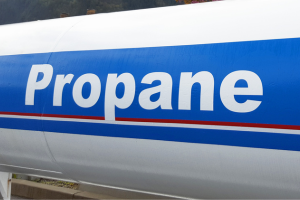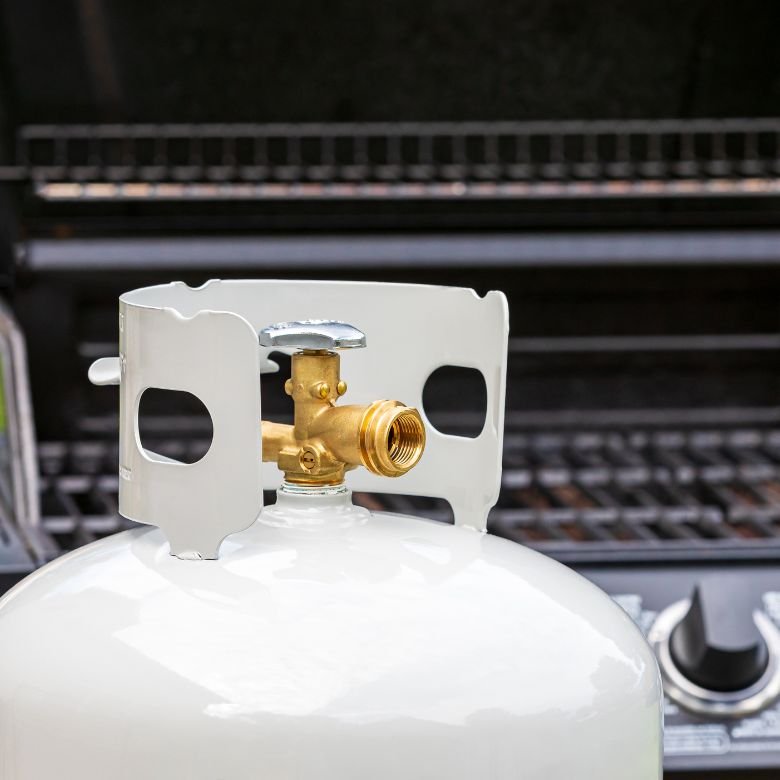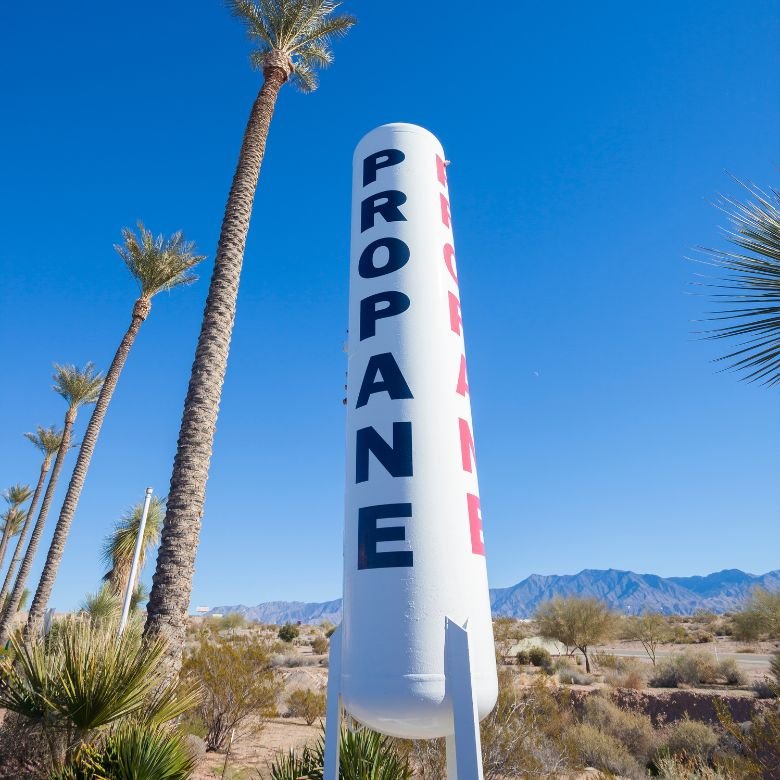Along with methane and ethane, propane is another example of a saturated hydrocarbon belonging to the alkane homologous series. It is one of the cheapest energy sources successfully used in industry. Propane is used, e.g., in the energy, chemical and cosmetics industries, as well as in the automotive sector.

General characteristics of propane
Propane is the third compound in the alkane homologous series, with the molecular formula C3H8. It is made up of three carbon atoms and eight hydrogen atoms. All bonds present in the propane molecule are saturated.
Propane is most often stored as a liquid in pressurised tanks. When the cylinder is emptied, the liquid propane evaporates due to a drop in pressure and changes to a gaseous state. It is a colourless and odourless gas, which is why an odorant is very often added. The characteristic odour makes it possible to quickly detect escaping or leaking gas from gas installations. Similarly to the other alkanes, propane has low chemical reactivity, which ensures that its structure remains unchanged during storage. Propane vapour is heavier than air, so it tends to fall and settle low to the ground.
Physico-chemical properties of propane
- colourless and odourless gas
- insoluble in water
- dissolves well in ethanol and diethyl ether
- forms an explosive mixture with air
- density greater than that of air
- non-toxic gas
The largest volumes of propane come directly from oil and gas processing. It is usually extracted from crude oil by distillation, in the form of a mixture with butane. As a fossil fuel, propane is often found alongside other gases such as methane, ethane or butane. On a laboratory scale, it is usually obtained by a synthesis using, e.g., butyronitrile and sodium. In addition, propane can also be obtained as a by-product of renewable diesel refining. In the future, if the heating industry increasingly uses renewable diesel as a fuel, propane production may become increasingly important, which in turn will make propane an environmentally friendly alternative fuel. Moreover, the gas is not harmful to the environment. In the event of a spill or release, it poses no risk to soil, surface water, or groundwater.
As with the other alkanes, propane primarily undergoes combustion reactions. Depending on the amount of oxygen involved in the process, a distinction is made between complete and incomplete combustion reactions. In the first case (with an unlimited supply of oxygen), the products are carbon dioxide and water. It is the most beneficial as regards energy. In the other case (limited supply of oxygen), the reaction produces carbon(II) oxide – the poisonous carbon monoxide – and water, or elemental carbon and water.
In addition to combustion reactions, propane also reacts with halogens. In practice, these are usually molecules of chlorine or bromine. Such reactions have a radical mechanism, and the whole process is initiated by light. During chlorination or bromination, one of the hydrogen atoms in the propane molecule becomes separated and is substituted with a halogen radical. The separated hydrogen atom combines with the other radical to form a hydrogen halide molecule, i.e., hydrogen chloride or hydrogen bromide, respectively. However, note that for alkanes with longer molecules than ethane, isomeric products are formed during halogenation. In the case of propane, a primary carbon atom or a secondary carbon atom can be substituted. The reactivity of carbon atoms in propane, with different ordering values, was determined experimentally. The secondary atom is the most reactive one – it is the easiest to separate from the compound molecule. Remember that bromination or chlorination produce not a single derivative, but a mixture of derivatives. The one in which the halogen is substituted to the secondary carbon atom always predominates. Furthermore, the bromination reaction is extremely selective. Typically, the yield of the main product reaches almost 99%.

Industrial application
- Propane is primarily a valuable source of energy. Due to its high octane number, it is very suitable for use as a fuel for internal combustion engines. Propane is the third (after petrol and diesel) most widely used transport fuel in the world. Propane used in vehicles is referred to as HD-5 propane and is a mixture of propane with smaller quantities of other gases. Such fuel should consist of at least 90% propane, up to 5% propylene and 5% other gases, mainly butane and butylene. Propane has a higher octane number than petrol, so it can be used at higher engine compression ratios and is more resistant to engine knocking.
- Domestic heating systems (designed, for example, for room or water heating) use propane as the heating fuel. It is becoming highly popular among homeowners because of its efficiency, versatility and availability in areas that are not supplied by natural gas lines. Home heating by burning propane provides the same comfort and efficiency as burning natural gas. Moreover, it can heat faster and keep your home warmer for longer than with electric heating. It is worth remembering that when heating with propane, it is essential to install carbon monoxide detectors in the home, as carbon(II) oxide is produced by burning the fuel. Carbon(II) oxide, commonly called carbon monoxide, is an odourless and highly poisonous gas.
- Propane is also an excellent refrigerant in refrigerating machines. It is typically used in small and medium-sized air conditioning and refrigeration units. This factor is technically cost-effective in all these units. In this case, the disadvantage of using propane is its high flammability. This proves particularly dangerous if the system leaks or is depressurised. Concerns about fires and fire protection issues have seriously hampered the widespread use of propane as a refrigerant in recent years.
- Propane is also one of the basic raw materials used in the chemical industry. It is used to obtain numerous derivatives, including acrylic acid, propionic acid and propylene.
- Interestingly, propane is used in gas dryers for drying clothes. Such dryers are a good alternative to electric dryers.
- In the cosmetics industry, propane is used to fill containers with aerosols.

The main propane derivatives
Propanol
One of the derivatives of propane is propanol, which belongs to the homologous series of alcohols. Propanol is a colourless and transparent liquid with a characteristic pungent odour. It dissolves very well in water and ethanol. It is a flammable liquid. It forms an explosive mixture with air. Propanol occurs in two isomeric forms – n-propanol and 2-propanol, also known as isopropanol, depending on which carbon atom in the molecule the hydroxyl group (-OH) is attached to. The compound is not safe for humans. It damages the nervous system and causes narcotic states. The vapours of this substance cause drowsiness, dizziness, and visual and olfactory disorders.
Propanol is mainly used in the chemical industry, primarily as a solvent. It can also be found as an ingredient in preparations for cleaning and disinfecting surfaces for use in medicine and the food industry.
Propionic acid
Propanoic or propionic acid is an example of a carboxylic acid with the molecular formula C2H5COOH. It is characterised by the presence of the carboxyl group -COOH in the molecule. This acid takes the form of a colourless, oily liquid and is highly soluble in water. Propionic acid is characterised by a very pungent, unpleasant odour. The substance is flammable and its mixture with air is explosive. It occurs in milk and in the digestive tract of animals. It is also produced in the human body as a result of the breakdown of sugars, fibre and pectins by bacteria. This process is called propionic acid fermentation.
One of the most important uses of propionic acid is its application in the food industry. It is a good food preservative with the symbol E-280. It is added to confectionery, sliced bread and rye bread. In animal feed, propionic acid is used as a mould inhibitor.
Glycerol
Glycerol (or glycerine) is a representative of the triols. Its systemic name is propane-1,2,3-triol. It belongs to the group of polyhydroxy alcohols. The glycerol molecule consists of three carbon atoms. One hydroxyl group (-OH) and hydrogen atoms are attached to each carbon atom. Glycerol is a colourless, odourless, oily liquid. It is characterised by high flammability and hygroscopicity. The presence of as many as three hydroxyl groups makes it easily soluble in water – it mixes with water without restriction. Glycerol is highly chemically reactive. It undergoes combustion and esterification reactions with nitric acid. It also reacts with active metals, resulting in the formation of salts called alcoholates.
Glycerol is mainly used in cosmetics. It is an ingredient in products to be applied directly on the skin, such as creams, lotions and gels. Glycerol-containing cosmetics are particularly recommended for people with sensitive and dry skin and those suffering from skin diseases (psoriasis, eczema, atopic dermatitis, etc.). Besides the cosmetics industry, glycerol is also used in the food industry. It is an ingredient in food colourings, is used as a sweetener and is also used to regulate and maintain moisture levels.
- https://pubchem.ncbi.nlm.nih.gov/compound/Propane
- https://afdc.energy.gov/fuels/propane-basics
- https://www.britannica.com/science/propane
- "Front Matter". Nomenclature of Organic Chemistry : IUPAC Recommendations and Preferred Names 2013 (Blue Book). Cambridge: The Royal Society of Chemistry. 2014. p. 4.